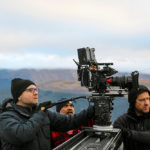
Air force
Posted on Jul 23, 2019
Our annual coverage of the art of aerial cinematography sees more R&D and greater demands on what aerial can achieve

Words Matt Snow / Pictures VARIOUS
Out of all the news we gathered at the start of the year, the fact that an aerial company had built their own drone was one we didn’t see coming. The DJI takeover was seen to be insurmountable and the heavy lift world was also seemingly set.
Helicopter Film Services, however, has kept at the top of the business by pushing the barriers and investing in its own engineering offering, and both of these are at the root of its pursuit of its own drone platform.
Jeremy Braben explains the route to market for the Titan drone. “We built it to satisfy the demands we were getting to fly certain camera packages, primarily the Alexa 65. At the same time, we were asked to fly film cameras.” The film angle makes perfect sense with the recent uptake on the use of the medium which we covered in last month’s issue (Rise of the super labs, April 2019).
“That is a big heavy lump to lift, with a 400-foot load of film, an Arri 435 body or a Panaflex body which we have to carry. So we wanted to create something that could do all of that.” And Jeremy quickly realised that there was nothing in the market that could carry that payload for the time he required it to. “Pre-built, there was nothing. There are different aircraft around that maybe could help but they are not in the film world and much bigger. We needed a gimbal, too, one that we wanted and that could take those particular cameras. Arri’s SRH-3 gimbal, for example, was developed by them with another German engineering company; we’ve integrated that into the Titan and we know that it can take the Alexa 65 camera and all the Arri controls. It’s a nice seamless way of using those products.
“The other one we have is a bigger gimbal that can take the film cameras because it’s a slightly different layout of gimbal. So we’ve designed an aircraft that can lift both of these gimbals for all of these applications that we see a need for.”
 The new Titan drone from Helicopter Film Services
The new Titan drone from Helicopter Film Services
In-house design
HFS’ Titan drone was completely designed and constructed in its own engineering department. “The development has been going on for around a year and we showed the prototype at the BSC earlier this year,” says Jeremy. “We’re building the production model at the moment. I doubt we’ll build it for anyone else but we’re building more than one for ourselves. I might entertain selling them into different markets but perhaps not in this one.” HFS created a new company last year within their parent company called Unmanned Flight Services; and an academy is included in that as well.
 Recently Shotover achieved a huge 24k plate with three Red Monstros on their sides
Recently Shotover achieved a huge 24k plate with three Red Monstros on their sides
“We’ve got a pool of talented people and we’re using our existing camera technician engineers for drawings and manufacturing. A lot of the parts are commercially available, we’re not building new motors so nothing is too bespoke.
“Titan carries a ballistic recovery feature; interestingly most of the other aircraft out there were not designed for the extra weight of a parachute, although the Shotover U1 can have a parachute and there are a few others around that do. Ours can be tested and repacked; we were keen to have this triple redundancy, we’re just trying to minimise the risk.
“Battery management is of course a big thing and we’ve had to work around existing technology. That technology hasn’t really allowed us more power along with less weight yet. But as new chemistries come on and new technology we’ll obviously adopt that and it will help, I hope, to reduce the weight.
“We’re also looking at a lot of other industries to market our drone; there are a lot of other applications and some of them involve small and very lightweight aircraft.”

Virtual world
HFS, along with other aerial services, is now more commonly asked to capture for the virtual world through airborne Lidar and photogrammetry to name a couple. HFS’ involvement with VFX has grown over the last year as requested by their customers. “We’ve seen how these productions have deployed different technologies on the ground,” says Jeremy, “and we wondered if there was some way of integrating that in the air. We’ve spoken to quite a few different VFX supervisors and houses and asked if this could be of use to them. That’s where the Lidar use came about; we’ve used it on helicopters quite a bit and we’ve integrated Lidar and a large format camera in a stabilised system to capture off both elements at the same time, so you’re minimising the number of runs. Hopefully there is an economic benefit to using a single pass system as opposed to doing multiple passes.”

Getting the shots
John Marzano is a hugely experienced aerial cinematographer with an impressive list of credits including the Downton Abbey movie, Artemis Fowl, Black Panther, Jason Bourne and many more (check his site for the whole list). We asked John how the requirement for movie shooting has changed. “We’re still asked to do very dangerous, for want of a better word, shots that require very low-level flying both for the helicopter and drones that we provide productions with nowadays,” he says. “For example, I’ve just come back from a shoot abroad where we had to fly the helicopter at about five feet off the ground for a shot, passing very close to the stunt crew we were filming.
“There’s a demand for those shots that push the safety envelope. We’ve been testing on another production with our Alta 8 drones which requires us to also fly extremely low over water and very close to a stunt performer. That’s very challenging.
“Speed is important sometimes – if we’re doing air to air for example at around 90knots and a rotor distance apart – but similarly the two shots I’ve just described to you on two different shows are extremely slow, walking pace in fact.
“We did a shot recently for Hobbs & Shaw inside a large auditorium. It was a long tracking shot overhead the action that was taking place. Traditionally productions would have had to put up an obtrusive wire- cam system in order to get the shot that we did. We were able to set-up in ten minutes, go for a take and job done.”

 John Marzano shot the aerials for Artemis Fowl; they were shot using the Red Weapon while on the ground it was all film
John Marzano shot the aerials for Artemis Fowl; they were shot using the Red Weapon while on the ground it was all film
John is shooting for the 25th Bond film at the moment with the IMAX camera, using the Eclipse XLHD with 1000 feet of film to give John about four to five minutes of screen time running at 24fps. “The Eclipse has this unique ability of geo pointing, so I can target a specific spot on the ground and memorise that GPS coordinate both in lat-long and height; and then we can fly away from our start position and I just tell the system to line me up on that memorised position so the camera automatically points to that spot.
“We then start the run-in and I’ve got a display on my screen of exactly where that memorised spot is within my frame. So we can always hit that mark absolutely bang on. For example, if you’re flying across a large piece of forest trying to find a clearing and you’re low level over the trees, it’s almost impossible to spot where the clearing is. The system allows me to nail the shot pretty much on take one.”
New gimbal, new market
Shotover’s new gimbal is its move to fill the gap between drones and full-sized helicopter shooting
The new Shotover B1 gimbal is the smallest one Shotover has ever made and that has some advantages and disadvantages. Firstly, you can’t fly the cameras you usually do; but that does open another market as Brad Hurndell, CEO of Shotover explains. “With the B1 you’re looking at maybe cinema mirrorless cameras like the Sony A7s with maybe a 20-120x lens. The B1 is still six-axis like the bigger models, so it gives you all that functionality.
“We’re looking at a whole new market segment with the B1, a wider market. Customers for it would be looking at filling a gap between the full-sized helicopters and the drone market. It’s guys who want to shoot aerials but don’t want to muck around with transportation issues or crew or approvals for the drone. Maybe their customers can’t afford a full-size helicopter with that hourly rate.
“Smaller TV stations maybe in up- and-coming countries will look at the B1, also the branded content market and mirrorless cameras shooting Raw is just right for them. You’re talking about web content, TV and commercials too. This gives them the advantage of a zoom lens which is fully stable, which they won’t get on a drone.
“If you think you couldn’t afford aerials then with the B1 the chances are you can. If you look at our biggest gimbal, the K1, you’re saving about half a million dollars with the B1. We’re also offering a five-year warranty which gets you your maintenance parts and labour over that time. It really lowers the barrier to entry.”

 The move to smaller gimbals is an attempt to replicate the ease of drones
The move to smaller gimbals is an attempt to replicate the ease of drones







